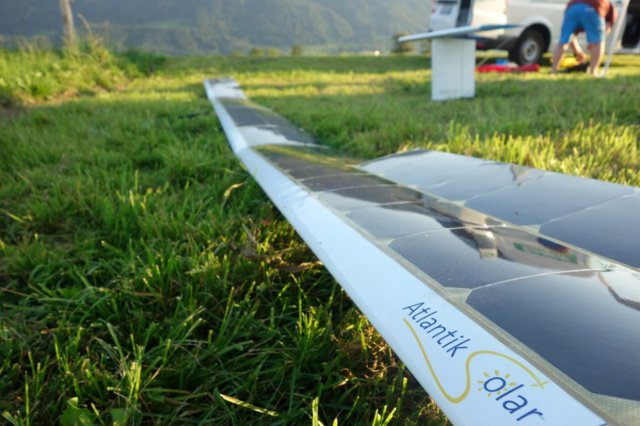Solar-powered drone Atlantik Solar has broken the world endurance record for unmanned aerial vehicles under 50kg — by flying continuously for 81 hours. It is also the second longest UAV flight ever, behind Airbus Space’s 53kg Zephyr 7. “We had to be extremely energy efficient, as we wanted to fly though the night, so we developed large and efficient batteries that supply that energy while flying in the darkness,” says Philipp Oettershagen, 28, one of the engineers behind AtlantikSolar.
Developed at ETH Zurich’s Autonomous Systems Lab, AtlantikSolar, which weighs just 6.8kg and has a 5m-wingspan, performed its flight at the Rafz, Switzerland, RC-model club airfield from 14 July. “We were hit by winds of up to 60km/h and thunderstorm clouds in the very last two hours of our flight,” Oettershagen tells WIRED. “To overcome this, we had to increase aircraft speed and altitude, and had to perform the landing through the Autopilot.”
In June 2016, the UAV will fly 5,000km across the Atlantic Ocean, on a pre-programed route from Boston to Lisbon over seven days. In order to prepare for this record-breaking journey, it will be testing longer journeys over the next six months, starting with a 12-hour flight in the Brazilian rainforest close to the Amazon River. “We’ll be flying from Belem to the Caxiuana research station in the middle of the rainforest, covering about 400km on solar-power alone,” says Oettershagen. “At the same time, we will be doing aerial mapping with our optical and infrared cameras and recording atmospheric information with our onboard sensors.”
Ultimately, squadrons of these mini-planes will be deployed to save human lives. “The ability to fly for days at a time means you can cover areas orders of magnitude larger than previous search missions have,” says Oettershagen. In June, the AtlantikSolar participated in the EU-funded search and rescue project ICARUS in Portugal, where it tested out victim detection flights over water for the first time. The project flies in the slipstream of existing solar-powered UAVs like Zephyr 7, which flew for 14-days non-stop. But its 22.5-metre wingspan would make Zephyr 7 unsuitable for emergency search and rescue missions, says Oettershagen. “With our plane, you can pack it away into a box for easy transportation, and one person can launch it by hand.”
Source: Wired

